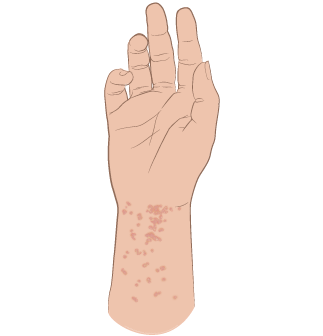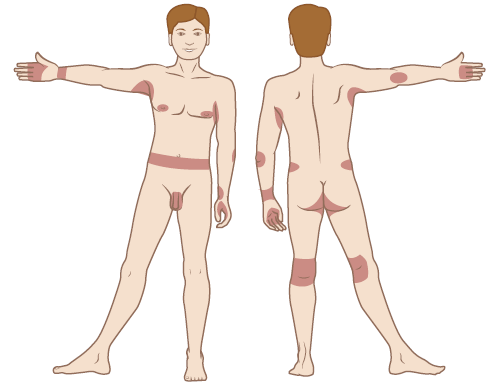This information will help you understand scabies, including what it is, how it’s treated, and how it’s spread.
About Scabies
Scabies is a skin condition caused by tiny mites. Scabies mites go into the top layer of your skin, where they live and lay eggs. Scabies makes your skin very itchy and can cause a rash of red bumps, blisters, or both.
Crusted scabies (also called Norwegian scabies) is a rare but serious form of scabies. You can get crusted scabies if your body has a hard time fighting the mites, so there are more of them living on your body. People who have a weak immune system, are elderly, or have a disability such as Down syndrome are more likely to get crusted scabies.
Signs and symptoms of scabies

The most common signs of scabies are:
- Feeling very itchy, especially at night.
- A rash made of red bumps, tiny blisters, flakes of skin, or all 3 (see Figure 1). The bumps may look like pimples, or they may be hard to see.
- Burrows (tiny tunnels in your skin where the mites have buried themselves).
The itching and rash can happen anywhere on your body, but they’re more likely to happen on or around the following areas (see Figure 2):
- Your fingers, especially the spaces and webs between them.
- The inside of your wrists.
- Your elbows.
- Your armpits.
- Your skin folds.
- The area around your nipples (especially for women).
- Your penis.
- Your waist and belt-line.
- Your buttocks.
- The area behind your knees.

If you have crusted scabies, you may also have thick, grayish crusts on your skin in 1 or more of these areas.
If a baby or child younger than 3 years has scabies, they may also have a rash on their head, face, neck, palms of their hands, or soles of their feet. Adults and older children usually don’t have a rash in these areas.
The itching can last for several weeks, even after the scabies mites are gone. Try not to scratch the rash. Scratching it can cause skin sores and lead to possible infection.
Diagnosing scabies
Your healthcare provider will tell you if you have scabies. They will ask you about your symptoms and will look for a rash or burrows on your skin. They may use a tool called a dermatoscope to look at the mites in your skin. They may also gently scrape your skin and look for scabies mites under a microscope.
Treating scabies
Killing the mites
Your healthcare provider may also prescribe a medication to kill the scabies mites. This may be a topical medication (medication you put on your skin) such as a lotion or cream, an oral medication (medication you swallow), or both.
- Adults and older children should apply the cream or lotion from their toes and feet all the way up to their neck, making sure to cover all their skin. Remember to apply it between your fingers, on your fingertips, and between skin folds of your body.
- Babies and children younger than 3 years should apply the medication over their entire body, including their head and neck. Topical medication is safe for children age 2 months or older. If your child is younger than 2 months, talk to their healthcare provider.
Apply the medication when your skin is cool and dry. Don’t apply it just after taking a bath or shower. Apply it in a thin layer on your skin and leave it on for 8 to 14 hours. After 8 to 14 hours, wash it off by taking a shower or bath. Don’t use a washcloth.
Most people need 2 or more applications, each about 1 week apart, to kill all the mites.
Because the itching is caused by a reaction to the mites and their waste, it may continue for several weeks after treatment, even if all the mites and eggs are killed.
Call your healthcare provider if the itching hasn’t stopped 2 to 4 weeks after your treatment, or if you notice a new rash or burrows. You may need to repeat the treatment or take an oral medication instead.
Talk to your healthcare provider before you go back to work or school.
Stopping the itching
Taking an oral antihistamine medication (allergy medication that you swallow, such as Benadryl®) can help to control the itching. You can buy an antihistamine at your local pharmacy without a prescription. Read the instructions that come with the medication to find out the correct dose. If a child has scabies, check with their healthcare provider to find out the correct dose.
If needed, your healthcare provider may also prescribe an anti-itch cream. Using Benadryl cream isn’t recommended.
Keeping from getting infested again
The people who have close contact with you, such as family members, roommates, or sexual partners, need to be treated for scabies at the same time that you are. Even if they don’t have symptoms, they could still have scabies mites on their skin. It’s especially important for people who you have had close skin-to-skin contact with to be treated.
It’s also important to wash everything in your home that could have scabies mites. Read the section “Removing scabies mites from your home” for more information.
How scabies is spread
Direct spread of scabies
Scabies is almost always spread by close skin-to-skin contact with a person who has scabies. Scabies is spread most easily between sexual partners and people who live together. A quick handshake or hug usually isn’t enough to spread scabies. A scabies mite can live on a person for 1 to 2 months and can spread to another person at any point during that time.
Indirect spread of scabies
Scabies can also be spread indirectly by sharing things such as clothing, towels, or bedding with a person who has scabies, but this is rare. Indirect spread of scabies usually only happens with crusted scabies. Without a person to live on, a scabies mite can survive for 2 to 3 days. Scabies is very unlikely to be spread by water in a swimming pool. Read the section “Removing scabies mites from your home” for instructions how to clean these items.
Animals can’t spread human scabies. Pets can get a different kind of scabies mite that can’t live on humans.
Going to your healthcare provider while you have scabies
If you have a appointment while you have scabies, tell the staff when you check in. They will bring you straight to an exam room. You should avoid spending time in waiting rooms, pantries, and other public recreational areas. Your family or friends who are in clinic with you should wash their hands with soap and water or an alcohol-based hand sanitizer.
Removing scabies mites from your home
Scabies mites die when exposed to high heat. To kill scabies mites on items such as bedding, clothing, and towels:
- Machine-wash the items using hot water and dry them in a clothes dryer using the hot cycle for at least 20 minutes.
- If items can’t be washed, place them in a sealed plastic bag. Keep the bag sealed for 5 to 7 days.
If a person in your home was diagnosed with scabies, wash all the clothes that everyone in the home has worn in the last 4 to 5 days. This will keep you or your housemates from getting re-infested with scabies from dirty clothes.
People with crusted scabies are very contagious. Vacuum the furniture and carpets in rooms used by the person with scabies. You don’t need to fumigate the living areas.
Call your healthcare provider if:
- You still have itching, a rash, or both 4 weeks after treatment.
- You have new red bumps, blisters, or skin flakes 1 week after treatment.
- Your rash starts to form a crust after treatment.
-
You have any of the following signs of infection:
- Any drainage from the rash.
- Pain at your rash.
- Skin that’s warm to touch.
- Spreading redness around your rash.
- Fever of 100.4° F (38° C) or higher.